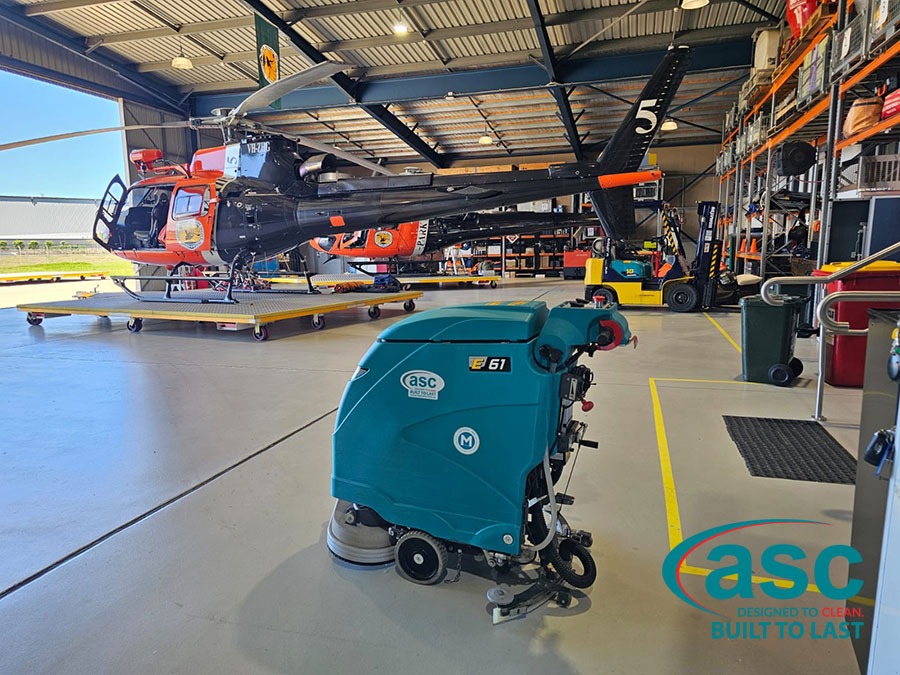Clean floors show care and attention. It helps prevent slips and injuries. For busy facilities, cleaning by hand takes too long.
Mops spread dirt instead of removing it. That is where a floor scrubber helps. It gets the job done faster, cleaner, and with less effort.
What is a floor scrubber, and how does it work?
A floor scrubber cleans hard floors quickly and evenly. It uses rotating brushes, water, and cleaning solution to lift dirt from the surface. Then it vacuums the dirty water into a recovery tank, leaving the floor dry and safe to walk on.
The key parts of a floor scrubber include:
- Brushes or pads that scrub the surface and remove dirt.
- A clean water tank that holds the cleaning solution.
- A recovery tank that collects dirty water.
- A squeegee and vacuum system that dries the floor right away.
This process keeps floors cleaner with less water and less manual work. You get consistent results each time you use it.
What are the main types of floor scrubbers?
There is no single type that fits every site. The right model depends on your space, floor type, and how often you clean.
- Walk-behind floor scrubbers
These machines are ideal for small to medium spaces like offices, workshops, and retail areas. They are easy to move and control. You guide the machine while it scrubs and dries the floor in one pass. - Ride-on floor scrubbers
If you manage a large warehouse, hospital, or production area, a ride-on model saves time. The operator sits and drives it like a small vehicle. These machines cover wide areas quickly and reduce fatigue. - Compact or cordless scrubbers
These work well for tight spaces and spot cleaning. They are light and easy to store. Cordless models remove the need for power points and cables, which makes cleaning safer.
How to choose the right floor scrubber for your site?
Buying a floor scrubber is an investment. To get value, you need a model that fits your site. Start by looking at these key points.
1. Size of your cleaning area
A walk-behind unit suits up to about 1,500 square metres. Anything larger may need a ride-on machine to save time.
2. Type of flooring
Smooth concrete, tiles, and vinyl all clean well with soft brushes. Rough or textured surfaces need stiffer bristles to lift dirt from grooves.
3. Power source
Corded ones work well in smaller areas where outlets are close. Battery units cost more upfront but save time by removing cable management.
4. Frequency of use
If you clean daily, pick a durable commercial model. Look for metal frames and strong motors. For occasional use, a lighter model may be enough.
5. Operator comfort
Controls should be clear and reachable. Handles or seats should feel stable. If the machine is easy to push or drive, staff will use it more often and finish faster.
How to use your floor scrubber effectively?
A floor scrubber works best when used with care. Follow these steps to get clean results and keep the machine in good shape.
- Inspect before use
Check that tanks are clean and hoses connected. Look at brushes and squeegees for wear. Make sure the battery or power cord is ready. - Fill the clean water tank.
Use the right cleaning solution for your floor type. Too much detergent can leave residue. Follow the maker’s mix guide. - Start cleaning
Move in straight lines and overlap slightly with each pass. This avoids streaks and missed spots. Do not rush. Let the brushes do the work. - Empty and rinse tanks after cleaning
Once finished, drain the dirty water and rinse the tanks. Wipe down the outside of the machine. This keeps it free from build-up. - Store properly
Keep it in a dry place. If it’s battery-powered, charge it after each use. Coil cords neatly to prevent damage.
Closing Thoughts
Using a floor scrubber helps you clean faster, safer, and with less effort. It cuts cleaning time, lowers labour costs, and keeps high standards across your site. It also removes more dirt and bacteria, which helps keep your workplace healthy.
A floor scrubber protects your floors from wear caused by dust and grit. That means fewer repairs and a longer life for your flooring. Clean floors also make your site safer for everyone who works or visits.
When you clean smarter, you save time and focus more on running your business with confidence and care.






